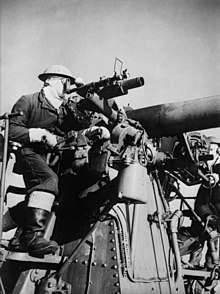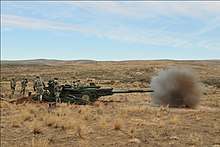Direct fire
Direct fire refers to the launching of a projectile directly at a target within the line-of-sight of the firer.[1] The firing weapon must have a sighting device and an unobstructed view to the target, which means no objects or friendly units can be between it and the target. A weapon engaged in direct fire exposes itself to return fire from the target.[2]

This is in contrast to indirect fire, which refers to firing a projectile on a ballistic trajectory or delivering munitions by guided or unguided missiles. Indirect fire does not need a direct line of sight to the target because the shots are normally directed by a forward observer. As such, indirect-fire weapons can shoot over obstacles or friendly units and the weapons can be concealed from counter-battery fire.
Description
Examples of direct-fire weapons include most ancient and modern weapons such as bows, handguns, rifles, machine guns, and recoilless rifles. The term is most often used in the context of artillery, such as howitzers and mortars.
Direct fire remained the dominant method of operating artillery throughout most of human history, with indirect fire used for sieges and involving specific siege guns.[3] Technological developments born of the Industrial Revolution and the development of technical practices in the late 19th century led to an appreciation of indirect fire, although it was not until World War I that indirect fire supplanted direct fire as the primary method by which artillery supported the other combat arms.[2] During World War II direct fire remained secondary to indirect fire, although it was used profusely in situations where indirect fire was less effective, and new direct-fire artillery such as anti-tank guns and anti-aircraft guns were developed.[4]

After World War II new technology continued to diminish the role of direct fire; however, in several situations it remains a necessary function on the modern battlefield. One of these is the defense of fixed fortified areas – for example fire support bases – for which specific firing techniques and munitions such as Killer Junior and Beehive anti-personnel rounds were developed. Another is when artillery is forced to defend itself, such as in a surprise attack. This could be the result of rapid maneuvering by ground forces, an attack by airborne troops, or from the lack of defined front lines as found in counterinsurgency operations. Direct-fire artillery can also be massed to counter a penetration by enemy tanks. In particular self-propelled artillery are ideally suited for this role on account of their mobility, armor protection, and faster rate of fire compared to other weapons.[5] A final situation is in urban warfare, where locating the enemy can be difficult, the physical structures give the defenders better protection, and the risk of collateral damage is high. In these cases direct-fire artillery can unleash tremendous firepower to precisely destroy enemy fortified positions.[6]
See also
- Gun laying
- Fire-control radar
- Director (military)
- Telescopic sight
- Line-of-sight (missile)
References
Footnotes
- Bailey, Johnathan B. A., Field Artillery and Firepower, Naval Institute Press, 2004, p.560
- p.49, Bailey
- p.211, Bailey
- p.50, Bailey
- p.51-54, Bailey
- p.83, Bailey
Bibliography
- Bailey, J B A (2004). Field Artillery and Firepower. Annapolis, MD: Naval Institute Press. ISBN 978-1-59114-029-0. OCLC 51931033.